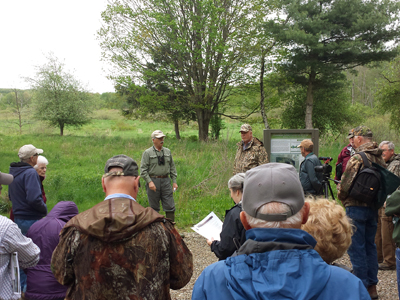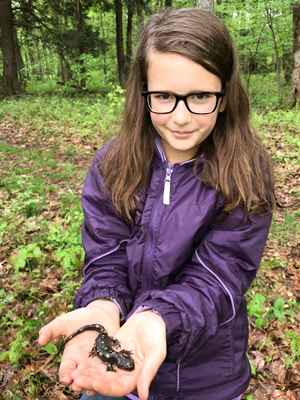 John Tautin knows a thing or two about wildlife species and their habitats in Crawford County. A former wildlife biologist and lifelong resident of the area, he made a career out of studying and observing animals, their behaviors and associated ecosystems.
John Tautin knows a thing or two about wildlife species and their habitats in Crawford County. A former wildlife biologist and lifelong resident of the area, he made a career out of studying and observing animals, their behaviors and associated ecosystems.
“I am still fascinated by wild plants and animals and the ongoing ways we can better protect our region’s vulnerable species and their habitats. I’m never bored when I’m in nature, because there is so much to appreciate and learn.”
Now retired, John shared this conservation ethic with nearly 50 people at a recent visit to Cussewago Bottom Conservation Area, a WPC-owned wetland within the French Creek Watershed.
French Creek is a renowned biodiversity hot spot. The river’s aquatic wildlife includes a diversity of freshwater mussels and fishes that is greater than that of any other small river in Pennsylvania or the Northeastern United States. There are records for 29 species of freshwater mussels and 90 species of fish in the watershed, as well as diverse communities of flora and fauna in a variety of wetland types and five natural glacial lakes. Throughout the French Creek watershed, WPC has protected approximately 5,000 acres of land to date.
“I grew up near here and still live nearby,” John, who is a WPC supporter, said of the 120-acre area that is open to the public for hunting and fishing. “This area used to be farmed. Today, this site is used heavily as a breeding ground by waterfowl, wood ducks, hooded mergansers, mallards and Canada geese.”
This conservation area also includes forested floodplain near Cussewago Creek, a major tributary to French Creek. Two large ponds exist on the property, and the wetlands are full of sedges and other waterfowl forage.
Another key WPC-owned wetland in the watershed is the 552-acre Helen B. Katz Natural Area. This property is named in memory of Mrs. Helen Blockstein Katz, who bequeathed more than $5 million to WPC. Thanks in part to her generosity, more than 4,000 acres of wild areas, rivers, forests, wildlife habitat and important natural communities have been protected. From the trailhead and property sign, a trail, which follows the slow-moving meandering Cussewago Creek, leads to a picturesque open area and pond that is surrounded by the forest.
This natural area features a combination of floodplain, wetland, bottomland forest and fields that provide habitat for a variety of wildlife. In addition to the large hemlock forested wetland, about 35 acres of former agricultural fields are reverting to forest. The Katz Natural Area is also open to the public for fishing, hunting and nature-watching.
Visiting the property for the first time on a spring morning were Ellery Troyer and his daughter, Mara, who spent time looking for salamanders during their walk. They plan to return soon to look for more wildlife and enjoy the natural beauty of the woods.
“Let’s look under here for some,” Mara said with inquisitive excitement as she lifted and looked underneath several branches and rocks along the trail. She eventually found a spotted salamander and a few toads.
Conservation efforts within the watershed would not be successful without the dedicated support from WPC members, conservation-minded supporters and landowners, and the work of the French Creek Collaborative. The collaborative is composed of WPC, French Creek Valley Conservancy, Ducks Unlimited, The Nature Conservancy, Audubon Pennsylvania and the Pennsylvania Environmental Council. The collaborative works together to raise awareness, conduct outreach, build local conservation capacity and protect exceptional places in the French Creek watershed.
“Thanks to our members and the partners in this collaborative, we are working together strategically to protect one of the most important watersheds in the country,” said Tom Saunders, president and CEO of WPC. “The land protection work in this watershed is a long-term effort. We appreciate the dedication of our members, landowners and partners who are working diligently and raising awareness about the importance of protecting this community and regional treasure.”
